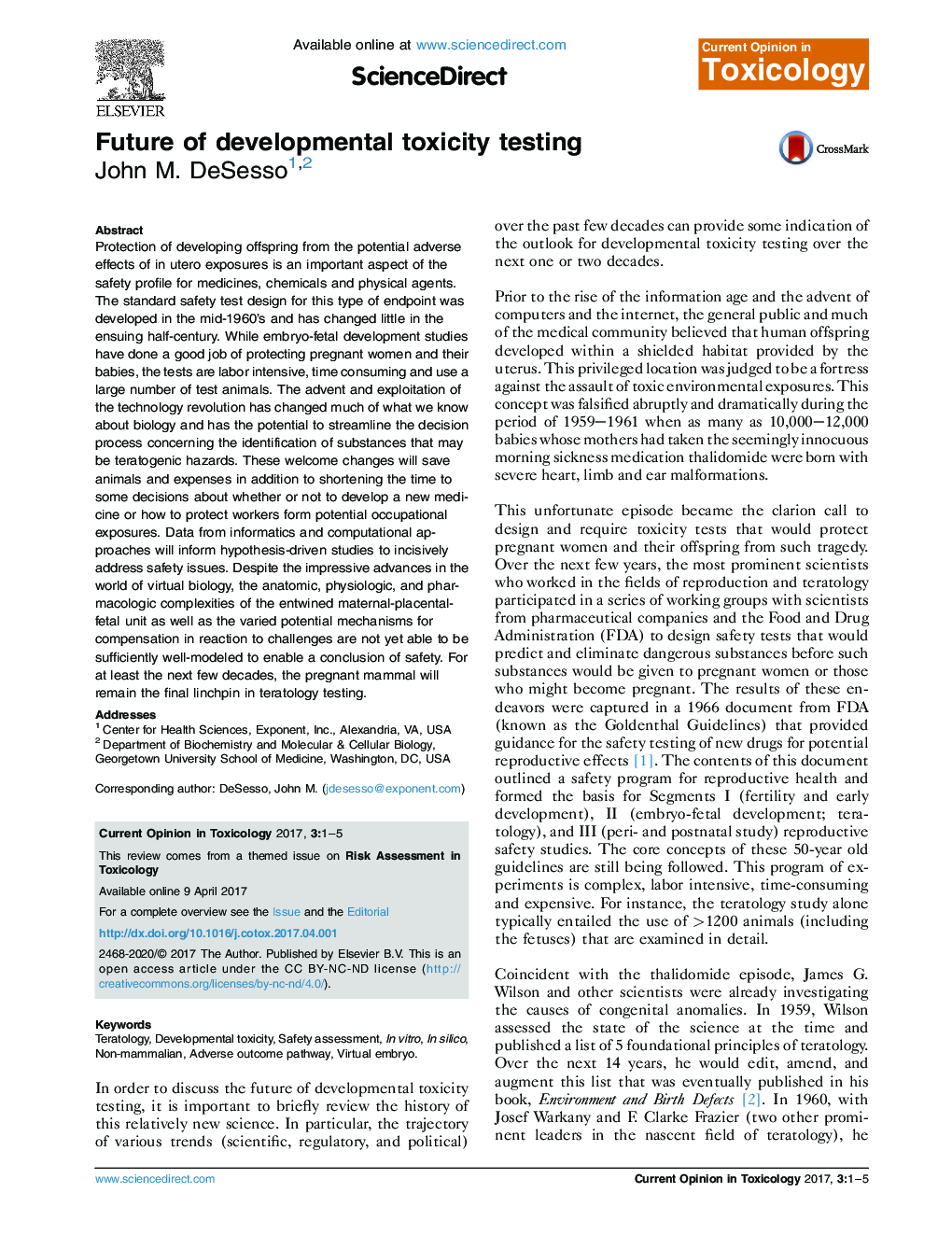| کد مقاله | کد نشریه | سال انتشار | مقاله انگلیسی | نسخه تمام متن |
|---|---|---|---|---|
| 8920253 | 1643350 | 2017 | 5 صفحه PDF | دانلود رایگان |
عنوان انگلیسی مقاله ISI
Future of developmental toxicity testing
ترجمه فارسی عنوان
آینده تست سمیت توسعه
دانلود مقاله + سفارش ترجمه
دانلود مقاله ISI انگلیسی
رایگان برای ایرانیان
کلمات کلیدی
ترجمه چکیده
حفاظت از فرزندان در حال رشد از عوارض جانبی بالقوه در مواجهه با رحم، جنبه مهمی از مشخصات ایمنی داروها، مواد شیمیایی و عوامل فیزیکی است. طراحی استاندارد ایمنی آزمون برای این نوع نقطه پایانی در اواسط دهه 1960 توسعه یافت و در نیم قرن بعد کاهش یافته است. در حالی که مطالعات توسعه جنین انجام کار خوبی در حفاظت از زنان باردار و نوزادان آنها بوده است، آزمایش ها کار فشرده، وقت گیر و استفاده از تعداد زیادی از حیوانات آزمایش شده است. ظهور و بهره برداری از انقلاب فناوری، بسیاری از آنچه که ما در مورد زیست شناسی می دانیم تغییر کرده است و می تواند فرآیند تصمیم گیری را برای شناسایی مواد خطرناک تراتوژنیک ساده تر کند. این تغییرات خوشامدگویی حیوانات و هزینه ها را علاوه بر کوتاه کردن زمان تصمیم گیری در مورد اینکه آیا یک دارو جدید یا چگونه برای محافظت از کارگران در معرض قرار گرفتن در معرض شغلی بالقوه باشد را نجات دهد. داده های مربوط به فناوری اطلاعات و رویکردهای محاسباتی، مطالعات فرضیه مبتنی بر مطالعات را به طور قطع به مسائل ایمنی ارجاع می دهند. علیرغم پیشرفت های قابل توجه در جهان از زیست شناسی مجازی، پیچیدگی های آناتومی، فیزیولوژیک و دارویی در بخش مادر و جفت و جنین درهم آمیخته شده و همچنین مکانیزم های بالقوه بالقوه برای جبران در واکنش به چالش ها هنوز نمی توانند به اندازه کافی خوب باشند. مدل سازی شده به منظور نتیجه گیری از ایمنی. برای حداقل چند دهه آینده، پستانداران باردار در آزمایش تراتولوژی باقی خواهند ماند.
موضوعات مرتبط
علوم زیستی و بیوفناوری
بیوشیمی، ژنتیک و زیست شناسی مولکولی
زیست شیمی
چکیده انگلیسی
Protection of developing offspring from the potential adverse effects of in utero exposures is an important aspect of the safety profile for medicines, chemicals and physical agents. The standard safety test design for this type of endpoint was developed in the mid-1960's and has changed little in the ensuing half-century. While embryo-fetal development studies have done a good job of protecting pregnant women and their babies, the tests are labor intensive, time consuming and use a large number of test animals. The advent and exploitation of the technology revolution has changed much of what we know about biology and has the potential to streamline the decision process concerning the identification of substances that may be teratogenic hazards. These welcome changes will save animals and expenses in addition to shortening the time to some decisions about whether or not to develop a new medicine or how to protect workers form potential occupational exposures. Data from informatics and computational approaches will inform hypothesis-driven studies to incisively address safety issues. Despite the impressive advances in the world of virtual biology, the anatomic, physiologic, and pharmacologic complexities of the entwined maternal-placental-fetal unit as well as the varied potential mechanisms for compensation in reaction to challenges are not yet able to be sufficiently well-modeled to enable a conclusion of safety. For at least the next few decades, the pregnant mammal will remain the final linchpin in teratology testing.
ناشر
Database: Elsevier - ScienceDirect (ساینس دایرکت)
Journal: Current Opinion in Toxicology - Volume 3, April 2017, Pages 1-5
Journal: Current Opinion in Toxicology - Volume 3, April 2017, Pages 1-5
نویسندگان
John M. DeSesso,
